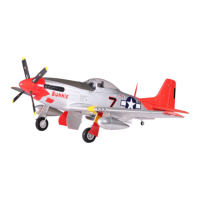
Do you have a question about the FMS 1700mm P-51 D Mustang and is the answer not in the manual?
| Wingspan | 1700mm |
|---|---|
| Retracts | Electric |
| Flaps | Yes |
| Material | Durable EPO |
| Skill Level | Intermediate |
| Battery | 6S 22.2V 4000mAh LiPo |
| Radio | 6 channel |
| Lights | Navigation lights |
| Servos | 9g x 8 |
| CG (Center of Gravity) | 110mm from leading edge |
Detailed safety guidelines for operating the model aircraft and handling its components.
Customer service information and contact details for feedback and suggestions.
Details and identification of all replacement parts available for the model.
Essential safety precautions regarding Li-Po batteries to prevent fire and injury.
Explanation of the ESC's function to protect the battery from over-discharge.
Instructions for attaching control horns to the elevator and rudder surfaces.
Instructions for attaching control horns to the aileron surfaces on the main wing.
Guide for inserting fiberglass and aluminum tubes into the main wing sockets.
Steps for connecting the main wing to the fuselage using the wing connector and bolts.
Instructions for securing the horizontal stabilizer and vertical fin to the fuselage.
Procedure for pairing the receiver with the transmitter for radio control.
Steps for physically installing the receiver within the model's fuselage.
Guidance on placing and securing the flight battery for proper weight distribution.
Steps for connecting control rods to horns and securing with clevises.
Procedure to verify correct movement and direction of control surface servos.
Adjusting control surface trims and servo arms for accurate response and alignment.
Connecting the control rods to the aileron servo horns and control surfaces.
Steps for attaching the decorative machine gun set and air exhaust stack.
Instructions for gluing the drop tank rack and attaching the drop tanks.
Details on ESC safe start, motor rotation, brake settings, and model specifications.
Procedure for checking control surface response and direction using the transmitter.
Verifying and adjusting control surface alignment with the trailing edge of the wing tip.
Setting the ATV/travel adjustment and dual rates for optimal control surface movement.
Steps for preparing the propeller and spinner components for assembly.
Securing the propeller assembly to the motor shaft with screws and nuts.
Fitting and securing the spinner to the propeller assembly using screws.
Instructions for applying maintenance markings to the aircraft based on illustrated examples.
Steps to adjust battery position for correct CG and balance the model.
Guidance on choosing a safe and appropriate location for flying the model.
Procedure for testing radio system range to ensure safe operation.
Tips on managing flight duration using a timer to ensure safe landings.
Instructions for initiating flight with proper control inputs for acceleration and climb.
Guidance on flying the model in open spaces, including general flight techniques.
Steps for safely landing the model, including managing power and gear.
Basic maintenance tips, including repairs and checking screws.
A guide to diagnosing and resolving issues related to aircraft response, vibration, and power.
Instructions for verifying the radio system's operational range before flight.
Tips for executing successful takeoffs and landings, including flap usage.
Essential steps to ensure the model is ready for its initial flight.
Rules for safe model aircraft operation, including flight conduct and prohibitions.
Specific rules and guidelines for operating radio-controlled model aircraft.
Regulations pertaining to free flight model aircraft operations.